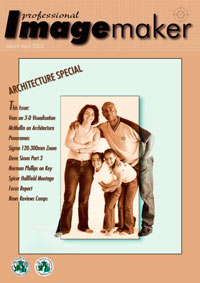articles/Fine-art/reproductionfineartp2-page1
The reproduction of fine art Part 2 - part 1 of 1 2
by Mike McNamee Published 01/03/2003
In the second part of this series Mike McNamee looks at some more of the fine detail required in the reproduction of fine art images for the limited edition prints market.
Coping with Reflections
You sometimes have to look hard to check that reflections are not interfering with your carefully crafted image. The author had a catalogue shot to show his students for many years. A very sophisticated table layout, complete with immaculate cutlery, cut glass, floral arrangements etc was adorned with an inverted image, in every single spoon, of the photographer decked out in Bermuda shorts and open toed sandals - it rather spoiled the ambience of the shot!
The following tips are useful
1. Use a black, non-reflective shield to hide the camera, with a hole for the lens aperture.
2. Use either a long cable release or the self-timer to make the exposure so that you can stand to one side.
3. Kill the room lights and blind any windows.
4. Consider using crossed polarisers on lighting and lenses. If the light is linearly polarised in one plane and the camera lens is linear polarized in the extinction plane, no reflections will show. This is particularly useful for impasto work in which it is impossible to position the lighting to avoid reflections. The technique is so good that you can photograph things that are under water or oil for scientific work, although this is not a requirement for artwork!
Colour Calibration Aids
Exposure should be judged with a competent incident light meter or by camera-based metering off a grey card. Follow the usual rules of ensuring that you do not burn out highlights in a transparency or digital image. The image is best shot with a calibration aid in place. Typically a Kodak Q13 Step Wedge and Colour scale are employed, as there are no issues of reflection. The Macbeth Color Checker or the Color Checker DC are also excellent.
Focussing and Vibration
Control If the artwork has a very diffuse structure you may have to place a thin paper target on it to assist focussing. Note that zoom lenses with push-pull zooming are notorious for moving during the course of shooting with the artwork-flat orientation. Tape up the controls if needs be.
Don't move around during the exposure, most especially if you are on a suspended floor. Avoid fixing equipment to walls, floors and ceilings that are "live". For example a wall tied to the roof trusses will move when wind is active on the roof and is termed live. People who dwell alongside railway lines also have to take care; we recall photographers who used to time their darkroom exposures to avoid the trains - fat chance of that with today's timekeeping! Use a cable release and lock your mirror up if you can. If your camera is an older one the chances are that the mirror will move up on first depression when the self-timer is used. Doing this ensures that the mirror bounce has subsided when the actual exposure is made. The cable release is even better if it is electronic and long so you can move away as well as activating the shutter with no mechanical force at all. A coloured shirt may reflect into your reproduction.
Optics
The choice of optics depends upon the fitting of the camera and maybe what is available in the studio. Zoom lenses should be avoided if possible and the best choice is a dedicated, flat field Macro Optic. They usually have focal lengths of 55, 60, 90, 105 or 200mm in 35mm format. Digital cameras, which factor up the focal length can cause you to rapidly run out of height on a copy stand. The down side of copying from very close is the additional distortion if the axes are not perfectly aligned.
The Nikkor 55mm f:2.8 macro lens is archetypal in its class. Optimised for flat field copying at A4 sizes, it is still listed by Nikon although it is becoming a rarity. It costs around £435 new, £275 used. Second hand it is classed as medium rare (owners do not like to part with them!) When we looked, Cambrian had one and the Jessops chain had 9 available. The AF 105mm Nikkor costs around £700. All of these older optics fit to the latest Nikon and Fuji Digital SLR's and the loss of some electronic functions should not impede artwork reproduction. Similar optics are available in the Canon ranges and obviously the Kodak digital models, based on specific lens marques, can take advantage of the optics available. Do check before you purchase though.
You are currently on page 1 Contact Mike McNamee
1st Published 01/03/2003
last update 09/12/2022 14:58:33
More Fine-art Articles
There are 19 days to get ready for The Society of Photographers Convention and Trade Show at The Novotel London West, Hammersmith ...
which starts on Wednesday 14th January 2026





